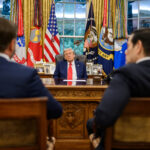Russia’s military-industrial complex (MIC), despite its aggressive expansion since the full-scale invasion of Ukraine, has remained critically dependent on fragile logistics networks, foreign suppliers, and unsanctioned civilian firms, according to “Disassembling the Russian War Machine,” a July 2025 report by the Kyiv School of Economics (KSE Institute). In the study, authors Lucas Risinger, Pavlo Shkurenko, Olena Bilousova, and Elina Ribakova offered a detailed breakdown of how Russia sustained its war effort and identified key vulnerabilities that Western policymakers could exploit.
The report found that Soviet-era stockpiles of tanks, armored vehicles, and artillery systems had been rapidly depleted. Deliveries from storage bases declined by more than 25% in 2024, and early 2025 data suggested that the trend would continue. Much of the remaining equipment was shipped directly to the front lines, bypassing traditional repair facilities. “Russia is … increasingly shipping equipment directly to the frontline instead of repair facilities,” the authors wrote, noting the emergence of restoration hubs near storage bases.
To compensate for domestic production shortfalls, Russia leaned heavily on foreign suppliers — particularly North Korea and Iran. Explosives suspected to be of North Korean origin accounted for 52% of all shipments to Russian arsenals in 2024. Iran also appeared to supply smaller volumes via the Caspian Sea. “This flow of munitions has propped up Russia’s war of aggression in the face of significant battlefield needs,” the report stated.
China emerged as an indispensable partner in sustaining Russia’s MIC. Machinery and automotive components from China dominated import flows, with logistics routed through a handful of MIC-affiliated firms. These firms consolidated control over Chinese shipping routes, concentrating cargo at strategic hubs around Moscow. “Chinese imports have supplanted domestically produced competition,” the authors emphasized, warning that the MIC’s reliance on Chinese inputs had become structural.
“Sanctions relief to Russia should be out of the question.”
The report also revealed that nominally civilian firms played a central role in supplying critical materials to the MIC. Companies such as Barrikada (reinforced concrete), UralChem and KAO Azot (explosives), and Achinsky Cement (industrial minerals) dominated their respective sectors but remained unsanctioned. “Single firms dominate the MIC’s supplies of raw materials, reinforced concrete, and explosives — yet are still considered civilian,” the researchers noted, calling for expanded sanctions.
Russia’s logistics network was described as centralized and increasingly oriented toward the frontline. Three-quarters of cargo movements were organized at the strategic command level, with volumes nearly tripling between 2021 and 2023. The MIC’s transport backbone relied on a limited number of hubs and firms, creating chokepoints that could be targeted by Western pressure.
Beyond the war in Ukraine, Russia had begun investing heavily in naval capabilities aimed at NATO. Cargo flows indicated a strategic focus on submarine and Arctic-capable vessel production. “Russia is investing heavily in naval capabilities to assert dominance in the High North,” the report warned, suggesting long-term ambitions that extended beyond the current conflict.
Despite large-scale state investments, the MIC remained constrained by inefficiencies, import reliance, and dwindling reserves. The authors argued that lifting sanctions would be a strategic mistake, enabling Russia to reconstitute its military capacity ahead of a potential confrontation with the West. “Sanctions relief to Russia should be out of the question,” they wrote.
The report concluded with a series of policy recommendations. Western governments were urged to widen the scope of economic pressure, sanction civilian entities supplying the MIC, and target logistics firms that bridge Chinese manufacturers with Russian military production. The threat of secondary sanctions should be used to deter Chinese companies and banks from facilitating transfers. “Credibly threatening secondary sanctions and halting all scientific and commercial ties with Russia would further weaken the MIC,” the authors advised.
Ultimately, the report portrayed Russia’s war machine as expansive but brittle — held together by foreign inputs, centralized logistics, and unsanctioned intermediaries. Disrupting these dependencies, the authors argued, could meaningfully constrain Russia’s capacity for prolonged warfare and future escalation.














